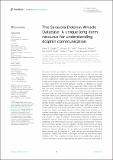Files in this item
The Sarasota Dolphin Whistle Database : a unique long-term resource for understanding dolphin communication
Item metadata
| dc.contributor.author | Sayigh, Laela | |
| dc.contributor.author | Janik, Vincent M. | |
| dc.contributor.author | Jensen, Frantz | |
| dc.contributor.author | Scott, Michael D. | |
| dc.contributor.author | Tyack, Peter Lloyd | |
| dc.contributor.author | Wells, Randall | |
| dc.date.accessioned | 2022-08-16T10:30:13Z | |
| dc.date.available | 2022-08-16T10:30:13Z | |
| dc.date.issued | 2022-08-04 | |
| dc.identifier | 276603053 | |
| dc.identifier | f13b3147-6cb6-4b10-8bdd-2c662c98f781 | |
| dc.identifier | 85136570864 | |
| dc.identifier | 000890903300001 | |
| dc.identifier.citation | Sayigh , L , Janik , V M , Jensen , F , Scott , M D , Tyack , P L & Wells , R 2022 , ' The Sarasota Dolphin Whistle Database : a unique long-term resource for understanding dolphin communication ' , Frontiers in Marine Science , vol. 9 , 923046 . https://doi.org/10.3389/fmars.2022.923046 | en |
| dc.identifier.issn | 2296-7745 | |
| dc.identifier.other | ORCID: /0000-0002-8409-4790/work/117567756 | |
| dc.identifier.other | ORCID: /0000-0001-7894-0121/work/117568875 | |
| dc.identifier.uri | https://hdl.handle.net/10023/25853 | |
| dc.description | Funding: Funding for data collection and analysis over the years has been provided by the National Science Foundation, The Royal Society of London, Dolphin Quest, Adelaide M. and Charles B. Link Foundation, Marine Mammal Commission, National Oceanic and Atmospheric Administration, Earthwatch Institute, Protect Wild Dolphins Fund of the Harbor Branch Oceanographic Institute, Grossman Family Foundation, WHOI Ocean Life Institute, Vulcan Machine Learning Center for Impact, and the Allen Institute for Artificial Intelligence. Current support for PT’s involvement is provided by the Office of Naval Research Grants N00014-18-1-2062 and N00014-20-1-2709 through a subaward from Carnegie Mellon University. Current support for LS’s involvement is provided by the Adelaide M. & Charles B. Link Foundation and Dolphin Quest. | en |
| dc.description.abstract | Common bottlenose dolphins (Tursiops truncatus) produce individually distinctive signature whistles that are learned early in life and that help animals recognize and maintain contact with conspecifics. Signature whistles are the predominant whistle type produced when animals are isolated from conspecifics. Health assessments of dolphins in Sarasota, Florida (USA) provide a unique opportunity to record signature whistles, as dolphins are briefly separated from conspecifics. Recordings were first made in the mid 1970’s, and then nearly annually since 1984. The Sarasota Dolphin Whistle Database (SDWD) now contains 926 recording sessions of 293 individual dolphins, most of known age, sex, and matrilineal relatedness. The longest time span over which an individual has been recorded is 43 years, and 85 individuals have been recorded over a decade or more. Here we describe insights about signature whistle structure revealed by this unique and expansive dataset. Signature whistles of different dolphins show great variety in their fundamental frequency contours. Signature whistle types (with ‘whistle type’ defined as all whistles visually categorized as sharing a particular frequency modulation pattern) can consist of a single stereotyped element, or loop (single-loop whistles), or of multiple stereotyped loops with or without gaps (multi-loop whistles). Multi-loop signature whistle types can also show extensive variation in both number and contour of loops. In addition, fundamental frequency contours of all signature whistle types can be truncated (deletions) or embellished (additions), and other features are also occasionally incorporated. However, even with these variable features, signature whistle types tend to be highly stereotyped and easily distinguishable due to the extensive variability in contours among individuals. In an effort to quantify this individual distinctiveness, and to compare it to other species, we calculated Beecher’s Information Statistic and found it to be higher than for any other animal signal studied so far. Thus, signature whistles have an unusually high capacity to convey information on individual identity. We briefly review the large range of research projects that the SDWD has enabled thus far, and look ahead to its potential to answer a broad suite of questions about dolphin communication. | |
| dc.format.extent | 20 | |
| dc.format.extent | 36813511 | |
| dc.language.iso | eng | |
| dc.relation.ispartof | Frontiers in Marine Science | en |
| dc.subject | Signature whistle | en |
| dc.subject | Communication | en |
| dc.subject | Cognition | en |
| dc.subject | Database | en |
| dc.subject | Individual identity | en |
| dc.subject | QL Zoology | en |
| dc.subject | QH301 Biology | en |
| dc.subject | NDAS | en |
| dc.subject | MCC | en |
| dc.subject.lcc | QL | en |
| dc.subject.lcc | QH301 | en |
| dc.title | The Sarasota Dolphin Whistle Database : a unique long-term resource for understanding dolphin communication | en |
| dc.type | Journal article | en |
| dc.contributor.institution | University of St Andrews.Sea Mammal Research Unit | en |
| dc.contributor.institution | University of St Andrews.Marine Alliance for Science & Technology Scotland | en |
| dc.contributor.institution | University of St Andrews.Scottish Oceans Institute | en |
| dc.contributor.institution | University of St Andrews.Institute of Behavioural and Neural Sciences | en |
| dc.contributor.institution | University of St Andrews.Centre for Social Learning & Cognitive Evolution | en |
| dc.contributor.institution | University of St Andrews.School of Biology | en |
| dc.contributor.institution | University of St Andrews.Bioacoustics group | en |
| dc.identifier.doi | 10.3389/fmars.2022.923046 | |
| dc.description.status | Peer reviewed | en |
This item appears in the following Collection(s)
Items in the St Andrews Research Repository are protected by copyright, with all rights reserved, unless otherwise indicated.

